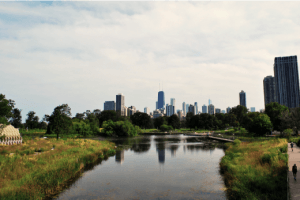by Samuel Kling
 Design and public health have intellectual linkages that stretch at least to the mid-nineteenth century, and involve ideas and people that public health professionals would scarcely recognize as their predecessors. In the United States, a high point in this relationship took place during the wave of rapid urbanization during the late nineteenth century. With this physical transformation came a host of social transformations brought by industrialization: extreme poverty and extreme wealth, multiethnic populations, and astounding physical chaos. One historian writes that epidemics of disease, social strife, and the prospect of class conflict proved so threatening to Americans in the late nineteenth century that many viewed the modern city as synonymous with disorder. The remedy for the disordered city was determined to be the public park, a reform initiative that brought an impressive level of design-driven change to city landscapes that endures today.
Design and public health have intellectual linkages that stretch at least to the mid-nineteenth century, and involve ideas and people that public health professionals would scarcely recognize as their predecessors. In the United States, a high point in this relationship took place during the wave of rapid urbanization during the late nineteenth century. With this physical transformation came a host of social transformations brought by industrialization: extreme poverty and extreme wealth, multiethnic populations, and astounding physical chaos. One historian writes that epidemics of disease, social strife, and the prospect of class conflict proved so threatening to Americans in the late nineteenth century that many viewed the modern city as synonymous with disorder. The remedy for the disordered city was determined to be the public park, a reform initiative that brought an impressive level of design-driven change to city landscapes that endures today.
Image of Chicago’s Lincoln Park from Wikimedia Commons.
About the Author
Samuel Kling is a History PhD candidate at NU. His dissertation, “Taming the Crabgrass Frontier: Regional Planning and the Metropolitan Idea in Chicago, 1900-1935,” rethinks the origins of mass suburbanization and metropolitan inequality in the US, focusing on the influential regional planning movement in Chicago.

